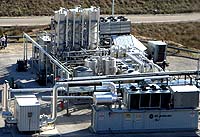
(By John Addison). It is a buyer’s market for those developing large wind, solar, bioenergy, biofuel, and other renewable energy projects. In 2009, land is less expensive , equipment cost less, deliveries are faster, and warranties longer. It is a buyer’s market if you have cash, yet it continues to be a difficult time to secure debt financing. This message was consistent from the majority attending the FRA Renewable Energy Finance and Investment Summit this week. I chaired the renewable fuels track and had a chance to talk with a number of developers and financers of renewable energy and fuels.
Demand for renewable energy is at a record high as U.S. utilities in about 30 states struggle to meet RPS (renewable Portfolio Standards). These utilities want to sign PPA (Power Purchase Agreements) for 5 to 20 years of wind power, solar, bioenergy, geothermal, and other renewable production. In the future, to meet targets these utilities may need to directly develop, own, and operate these RE plants. Many would need PUC (public utility commission) approval to make this part of their business model.
RE has been a historic opportunity for developers who would take projects through 3 to five years of analysis, regulatory approvals, securing equity and debt financing, buying equipment, program management, and operating the plant. Now, few investors and lenders have the appetite for risk, as projects such as ethanol plants have gone bankrupt.
Credit worthiness of developers, utilities and end users are scrutinized. For example, major public real estate owners of buildings, hotels, and shopping centers that want MW of solar cannot get the RE because their corporation or REIT has a sub-prime debt rating.
Risk is intensified as redundant regulation and NIMBY (not in my backyard) opposition can delay installation of high-voltage lines for 7 to 10 years from wind or solar farm to major cities that need more electricity. Even billionaire Boone Pickens was unwilling to tie-up money for that period of time.
New high-voltage lines can be done. Prairie Wind went from zero to a transmitting 345kV line in less than 3 years. It is now optimistic about completing a 110 mile 765kV transmission system in Kansas. Prairie Wind Transmission is a joint venture of Westar Energy and Electric Transmission America — a joint venture of American Electric Power and MidAmerican Energy Holdings Company. ITC Great Plains and Prairie Wind Transmission are authorized to build different segments of the Kansas V-Plan.
Although large-scale RE development in 2009 is beyond the financing capabilities of most entrepreneurs, it is an opportunity for major public companies with investment-grade bond ratings such as FPL Energy, GE Energy, Iberdrola Renovables, and EDF Energy Nouvelles. Wall Street analysts are forecasting record 2009 and 2010 earnings for Iberdrola and EDF.
Smaller wind and solar developers find that new developments are possible, though more difficult. Utilities are standardizing RFPs and making conditions more reasonable. Private equity money is available if investors can be convinced of high returns and low risk. David Perlman, Managing Director with investment banker Fieldstone Private Capital Group, reports that, “Liquidity is returning, but with fewer banks than before economic crisis, smaller lending commitments, shorter maturities, and club deals rather than syndications. Bankers might offer construction terms and an operating loan of no more than five years for developments that show little risk.
The ARRA (American Recovery and Reinvestment Act) has helped and hurt. More federal bureaucracy and slower release of money is reported. New wind and solar deals are more likely to use ITC than PTC. The cash flow for an ITC is sooner and more predictable. For many projects, the new Treasury Department Grant is even more favorable than ITC. Tax-exempt bonds are another avenue for financing RE projects reported John M. May, Managing Director of investment banker Stern Brothers. He identifies bioenergy and biofuel from solid waste are good targets for tax-exempt bonds.
Wind and solar developments are difficult. Biofuel debt financing is next to impossible according to conference participants. Bankrupt corn ethanol plants are being sold for pennies on the dollar, with Valero’s purchase of VeraSun assets being a prime example. Clean Fleet Ethanol Report. Cellulosic plants and algal fuel pilots are moving forward for those who have received equity investments in the tens and hundreds of millions, and do not require bank financing, including Abengoa, Enerkem, Mascoma, Poet, Sapphire, and Synthetic Genomics to name a few.
The demand is growing for renewable energy and fuels. The rewards are significant for the patient investor who can moderate risk with a portfolio of RE projects at various stages of approval. In 2009, the year of the Great Recession, cash is king.
